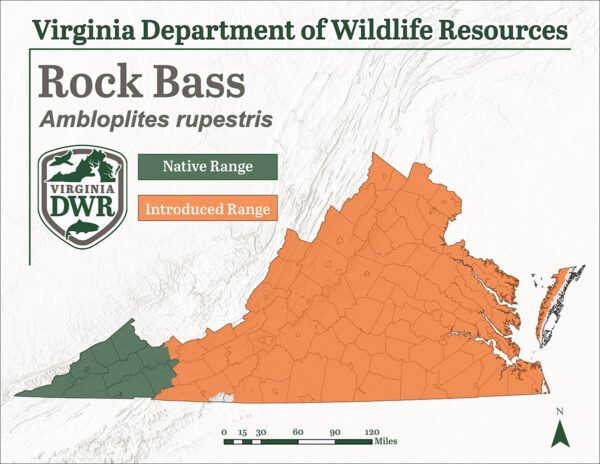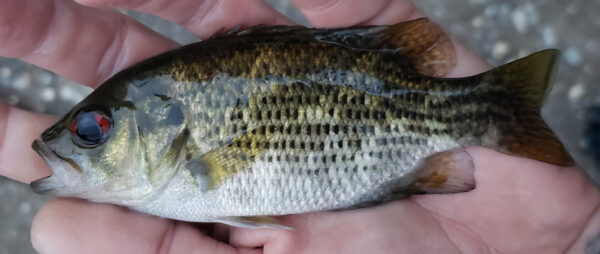A Rock Bass sits in an observation tank after a survey event.
An angler shows off a smaller Rock Bass. ©Photo by Dootin Branch
Fact File
Scientific Name: Ambloplites rupestris
Classification: Fish, Order Perciformes, Family Centrarchidae
Size: Rock Bass average 6 to 8 inches in Virginia, with larger specimens surpassing 10 inches
Life Span: Rock Bass can live up to 10 years in Virginia waters
Identifying Characteristics
- Red eye
- Short, robust body with a large mouth
- Lower jaw protrudes slightly
- Back is olive-green with sides tarnished gold or brassy colored.
- Lateral scales have pigmentation
- Large spots along the side form a striped-like appearance
- Has a discernable dark margin on its anal fin
- 5 spines on anal fin
Diet
The Rock Bass feeds upon crayfish, aquatic and terrestrial insects and small fish. Rock Bass are primary benthic feeders, but will feed at the surface in certain circumstances. The Rock Bass is often the apex predator of small warm water stream habitats in Virginia.
Distribution:
Rock Bass can be found in most watersheds in Virginia, but it is only native to the southwest portion of the state.

Habitat
Rock Bass thrive in clear flowing streams with cobble, boulders, and bedrock ledges. The Rock Bass is a schooling species of fish that is often found near hard structure or submerged aquatic vegetation.
Reproduction
Rock Bass spawn in the spring and summer. Male Rock Bass form nesting beds in gravel substrates. Female Rock Bass deposit eggs that adhere to the gravels in the nest, as the male fertilizes. Male Rock Bass exhibit territorial behavior, defending the nesting site and newly hatched young.
Last updated: July 18, 2024
The Virginia Department of Wildlife Resources Species Profile Database serves as a repository of information for Virginia’s fish and wildlife species. The database is managed and curated by the Wildlife Information and Environmental Services (WIES) program. Species profile data, distribution information, and photography is generated by the Virginia Department of Wildlife Resources, State and Federal agencies, Collection Permittees, and other trusted partners. This product is not suitable for legal, engineering, or surveying use. The Virginia Department of Wildlife Resources does not accept responsibility for any missing data, inaccuracies, or other errors which may exist. In accordance with the terms of service for this product, you agree to this disclaimer.


